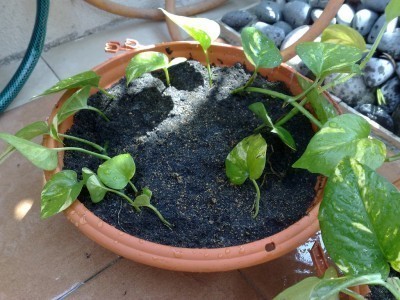






When you have some favorite plants that are outgrowing their place or need to replace some short-lived plants, taking cuttings is a good way to grow some replacements. It’s also a great way to increase the number of plants you have in your collection. Read on to learn more.
You don’t need anything more than some clean flowerpots, a sharp knife and some cutting compost. A few short sticks might come in handy to support the new cuttings as well.
You have to be sure you provide a lighted place with an even temperature of 55-64° F. (13-18 C.), (more for tropical plants). You can grow more than one cutting in each pot as well.
Plants like ivy (Hedera), and anything else that has long, trailing stems with leaves growing at intervals along the whole length, can be propagated from a simple cutting taken from a length of stem without the need for tips on how to grow it. They grow easily.
One long piece of stem can be divided into several pieces that can be planted up into pots of cuttings compost, watered and covered in a plastic tent until you see new growth. When new growth appears, it indicates that the young cuttings have taken root and are mature enough to safely be potted.
A leaf petiole cutting uses a leaf and its stalk (the petiole). If you have soft-stemmed plants, they root well this way and the method is often used for African violet (Saintpaulia).
Pick your plant by making sure it has plenty of leaves. Make sure the leaves you choose have firm, fleshy petioles. Cut the leaf stalks at the base, and trim the stems down until they are 3 to 4 cm long.
Dip the petiole tips in hormone rooting powder and place cuttings in a pot of cuttings compost. Make sure the pieces are standing so the leaf doesn’t get web. Cover the pot with plastic and keep it warm until new growth appears.
In order to take tip cuttings, pick a healthy plant with lots of well-developed stems. Take your cuttings from the outside of the plant because the newer, softer pieces won’t grow root well. Keep the cuttings in good light and warmth until new growth shows that roots have taken. In order to encourage bushy growth, pinch them out at the growing points as they grow.
When taking cuttings, use a sharp knife or scalpel to cut an 8 to 13 cm length of stem. Make sure the growing tip is at the end. Make your cut above the leaf joint or node and be sure to cut it at an angle away from the joint.
Just below the bottom of the leaf joint is where you should trim the stem. The leaf joint is where new roots will develop. You need to cleanly slide off the lower leaf or pair of leaves. If you are busy getting several cuttings, you can keep them in water until you’re ready to transplant.
You’ll want to make a hole in a pot of compost. Dip the cutting in rooting powder and stick it in the compost. You want to make sure the leaves are not touching it. Finally just water the compost from above. If you want to conserve moisture, you can make a tent with a plastic bag and put it over it.
When you take cuttings from the African violet, these leaf petiole cuttings can be rooted in water. Just cover the top of a bottle with kitchen paper held in place with a rubber band. Poke a hole in it and stick the cutting through it. If you keep it warm, light and draft free, you will ensure that you have a plenty of new violet plants to take care of.
If you are taking stem cuttings, using a sharp knife cut off a good length of stem. Cut the plant just above the leaf joints and divide the stems into small pieces. Make sure each piece has a leaf. Stick the cuttings into a pot of cuttings compost. You can place several to a pot. You don’t want to place the cuttings too close to the edges because the compost at the edges becomes too dry. Water the pot and then cover with a little plastic tent. Make sure the leaves don’t touch the plastic. When you see small new leaves, then the cuttings have rooted. These should then be transferred to smaller pots of potting compost.
All of these are great examples of what to do when you want more plants. These are easy to follow ideas for how to build your collection or improve your indoor garden. Sometimes it’s trial and error, but for the most part, once you get started, there’s just no better feeling than knowing you did this all by yourself.
Copyright © www.100flowers.win Botanic Garden All Rights Reserved